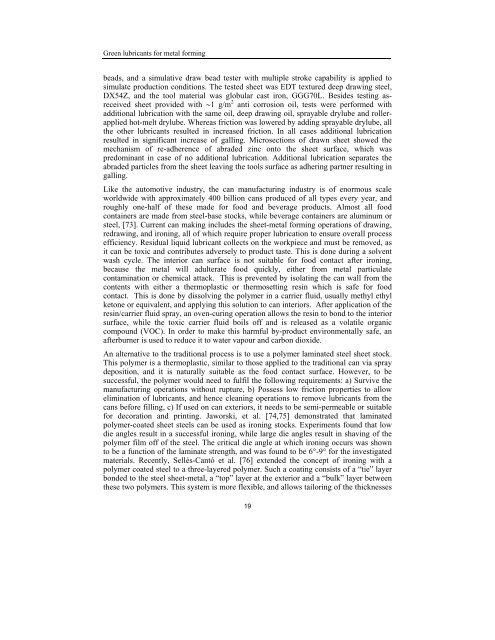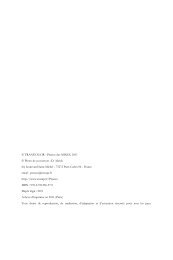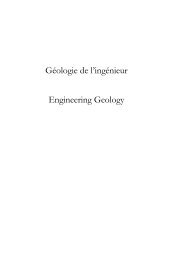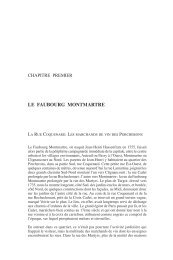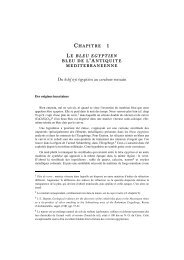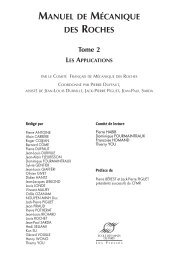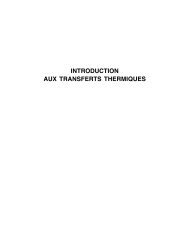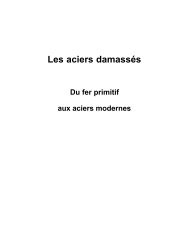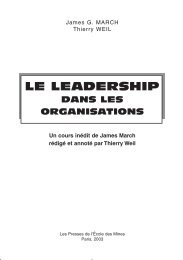Tribology of Manufacturing Processes - Presses des Mines
Tribology of Manufacturing Processes - Presses des Mines
Tribology of Manufacturing Processes - Presses des Mines
You also want an ePaper? Increase the reach of your titles
YUMPU automatically turns print PDFs into web optimized ePapers that Google loves.
Green lubricants for metal formingbeads, and a simulative draw bead tester with multiple stroke capability is applied tosimulate production conditions. The tested sheet was EDT textured deep drawing steel,DX54Z, and the tool material was globular cast iron, GGG70L. Besi<strong>des</strong> testing asreceivedsheet provided with ∼1 g/m 2 anti corrosion oil, tests were performed withadditional lubrication with the same oil, deep drawing oil, sprayable drylube and rollerappliedhot-melt drylube. Whereas friction was lowered by adding sprayable drylube, allthe other lubricants resulted in increased friction. In all cases additional lubricationresulted in significant increase <strong>of</strong> galling. Microsections <strong>of</strong> drawn sheet showed themechanism <strong>of</strong> re-adherence <strong>of</strong> abraded zinc onto the sheet surface, which waspredominant in case <strong>of</strong> no additional lubrication. Additional lubrication separates theabraded particles from the sheet leaving the tools surface as adhering partner resulting ingalling.Like the automotive industry, the can manufacturing industry is <strong>of</strong> enormous scaleworldwide with approximately 400 billion cans produced <strong>of</strong> all types every year, androughly one-half <strong>of</strong> these made for food and beverage products. Almost all foodcontainers are made from steel-base stocks, while beverage containers are aluminum orsteel, [73]. Current can making inclu<strong>des</strong> the sheet-metal forming operations <strong>of</strong> drawing,redrawing, and ironing, all <strong>of</strong> which require proper lubrication to ensure overall processefficiency. Residual liquid lubricant collects on the workpiece and must be removed, asit can be toxic and contributes adversely to product taste. This is done during a solventwash cycle. The interior can surface is not suitable for food contact after ironing,because the metal will adulterate food quickly, either from metal particulatecontamination or chemical attack. This is prevented by isolating the can wall from thecontents with either a thermoplastic or thermosetting resin which is safe for foodcontact. This is done by dissolving the polymer in a carrier fluid, usually methyl ethylketone or equivalent, and applying this solution to can interiors. After application <strong>of</strong> theresin/carrier fluid spray, an oven-curing operation allows the resin to bond to the interiorsurface, while the toxic carrier fluid boils <strong>of</strong>f and is released as a volatile organiccompound (VOC). In order to make this harmful by-product environmentally safe, anafterburner is used to reduce it to water vapour and carbon dioxide.An alternative to the traditional process is to use a polymer laminated steel sheet stock.This polymer is a thermoplastic, similar to those applied to the traditional can via spraydeposition, and it is naturally suitable as the food contact surface. However, to besuccessful, the polymer would need to fulfil the following requirements: a) Survive themanufacturing operations without rupture, b) Possess low friction properties to allowelimination <strong>of</strong> lubricants, and hence cleaning operations to remove lubricants from thecans before filling, c) If used on can exteriors, it needs to be semi-permeable or suitablefor decoration and printing. Jaworski, et al. [74,75] demonstrated that laminatedpolymer-coated sheet steels can be used as ironing stocks. Experiments found that lowdie angles result in a successful ironing, while large die angles result in shaving <strong>of</strong> thepolymer film <strong>of</strong>f <strong>of</strong> the steel. The critical die angle at which ironing occurs was shownto be a function <strong>of</strong> the laminate strength, and was found to be 6°-9° for the investigatedmaterials. Recently, Sellés-Cantó et al. [76] extended the concept <strong>of</strong> ironing with apolymer coated steel to a three-layered polymer. Such a coating consists <strong>of</strong> a “tie” layerbonded to the steel sheet-metal, a “top” layer at the exterior and a “bulk” layer betweenthese two polymers. This system is more flexible, and allows tailoring <strong>of</strong> the thicknesses19


